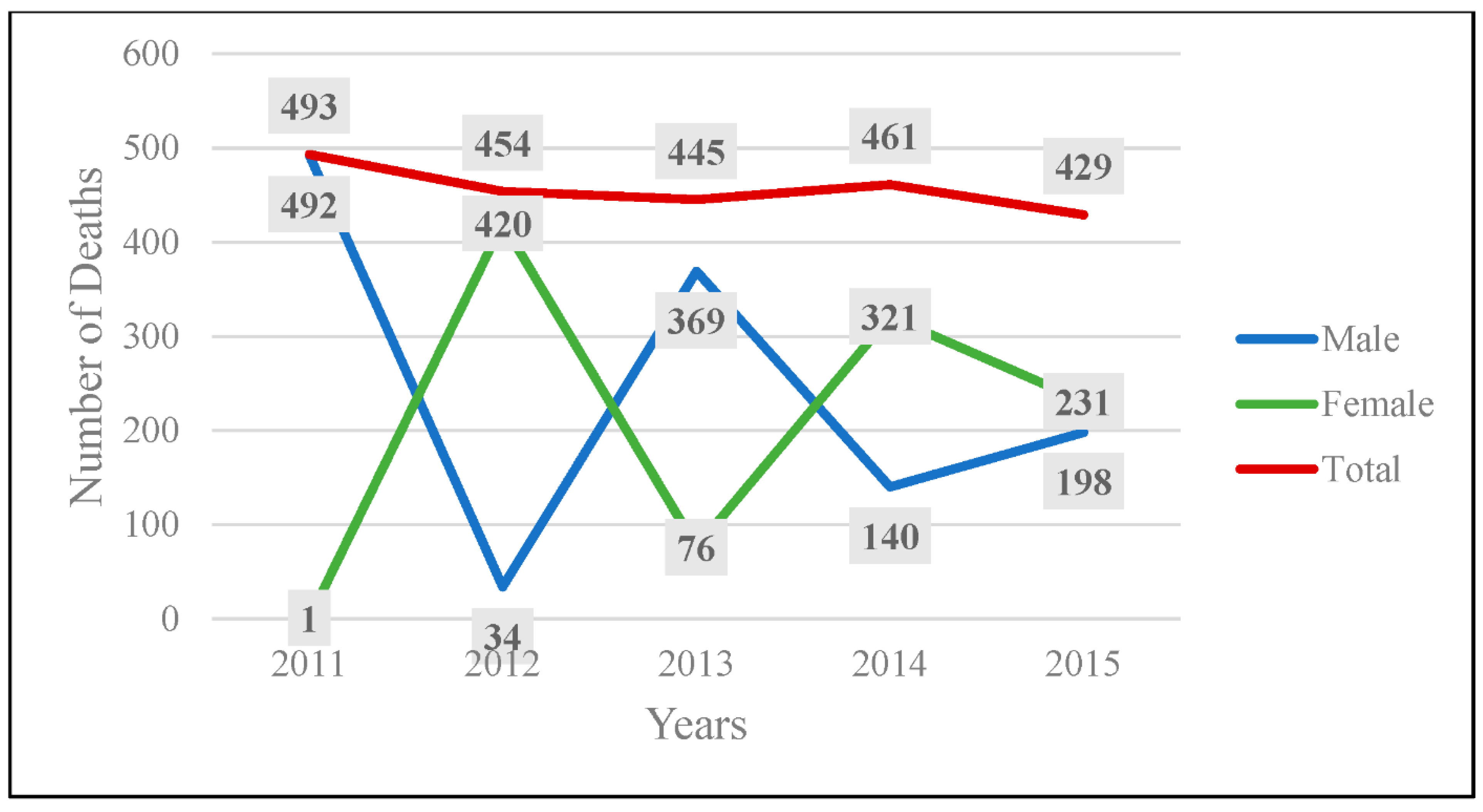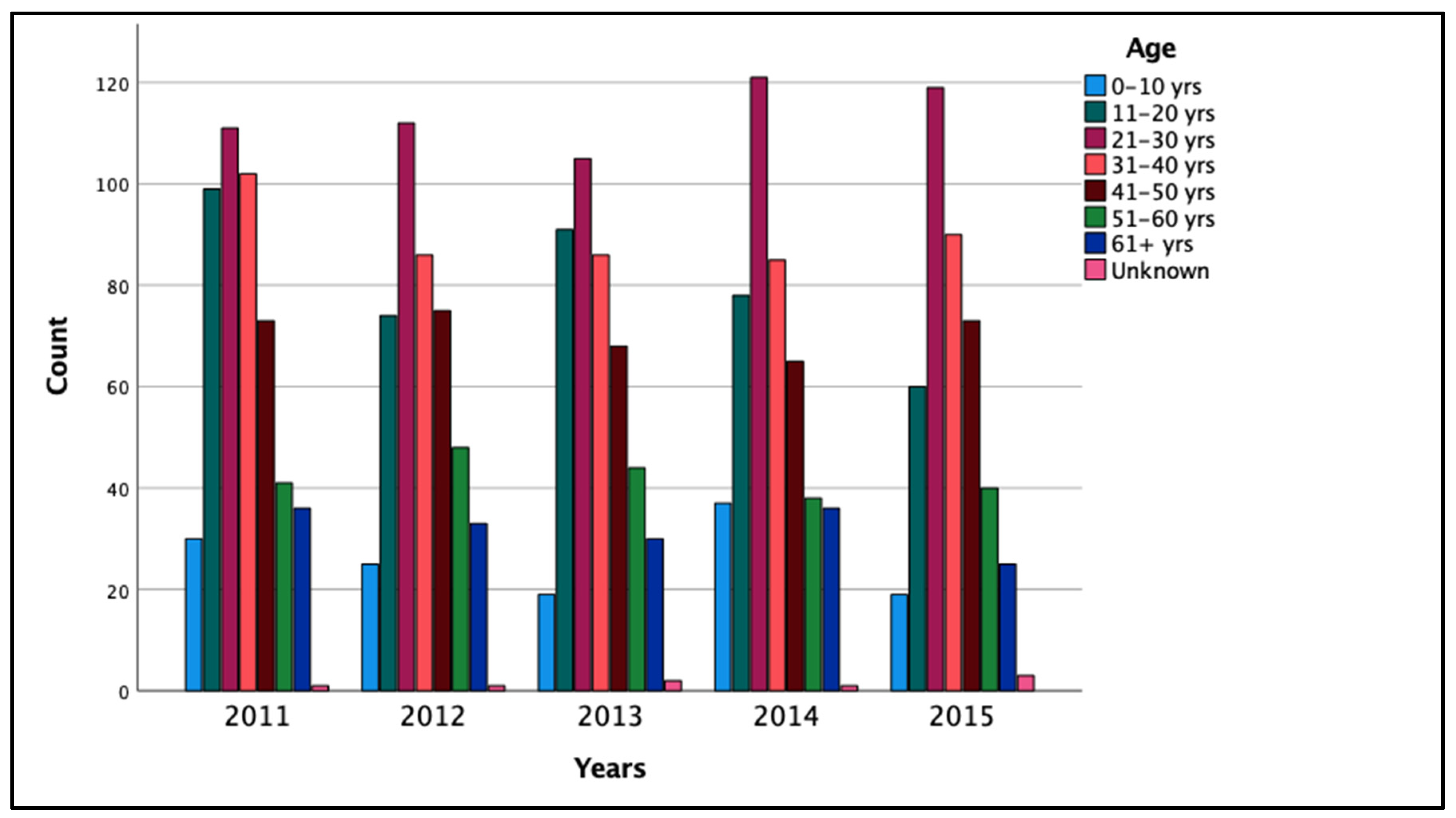Risky Roads in Kuwait: An Uneven Toll on Migrant Workers
Abstract
:1. Introduction
2. Methods
Data and Analysis
3. Results
3.1. Citations
3.2. Mortality
4. Discussion
4.1. Enforcement of Regulations
4.2. Citations
4.3. Mortality
4.4. Conceptualization of Potential Strategies
4.5. Strengths and Limitations
5. Conclusions
Author Contributions
Funding
Institutional Review Board Statement
Informed Consent Statement
Data Availability Statement
Acknowledgments
Conflicts of Interest
References
- World Health Organization. Global Status Report on Road Safety 2018; World Health Organization: Geneva, Switzerland, 2018. [Google Scholar]
- World Health Organization. Global Health Estimates 2019: Deaths by Cause, Age, Sex, by Country and by Region, 2000–2019; WHO Department of Data and Analytics: Geneva, Switzerland, 2020. [Google Scholar]
- World Health Organization. Global Health Estimates: Life Expectancy and Leading Causes of Death and Disability; World Health Organization: Geneva, Switzerland, 2019. [Google Scholar]
- World Health Organization. World Health Statistics 2018: Monitoring Health for the SDGs, Sustainable Development Goals; World Health Organization: Geneva, Switzerland, 2018. [Google Scholar]
- Ziyab, A.H.; Akhtar, S. Incidence and trend of road traffic injuries and related deaths in Kuwait: 2000–2009. Injury 2012, 43, 2018–2022. [Google Scholar] [CrossRef] [PubMed]
- Aldhafeeri, E.; Alshammari, F.; Jafar, H.; Malhas, H.; Botras, M.; Alnasrallah, N.; Akhtar, S. Period prevalence and factors associated with road traffic crashes among young adults in Kuwait. Injury 2018, 49, 939–944. [Google Scholar] [CrossRef] [PubMed]
- Al-Kandary, N.; Al-Waheeb, S. Patterns of accidental deaths in Kuwait: A retrospective descriptive study from 2003–2009. BMC Public Health 2015, 15, 302. [Google Scholar] [CrossRef] [PubMed] [Green Version]
- World Health Organization. Global Health Estimates: Leading Causes of Death, Kuwait 2019. Available online: https://www.who.int/data/gho/data/themes/mortality-and-global-health-estimates/ghe-leading-causes-of-death (accessed on 10 July 2022).
- Shanks, N.; Ansari, M.; Ai-Kalai, D. Road traffic accidents in Saudi Arabia. Public Health 1994, 108, 27–34. [Google Scholar] [CrossRef]
- Mansuri, F.A.; Al-Zalabani, A.H.; Zalat, M.M.; Qabshawi, R.I. Road safety and road traffic accidents in Saudi Arabia: A systematic review of existing evidence. Saudi Med. J. 2015, 36, 418. [Google Scholar] [CrossRef]
- Al-Bulushi, I.; Edwards, J.; Davey, J.; Armstrong, K.; Al-Reesi, H.; Al-Shamsi, K. Heavy vehicle crash characteristics in Oman 2009–2011. Sultan Qaboos Univ. Med. J. 2015, 15, e191. [Google Scholar]
- Hajeeh, M.A. Traffic Accidents in Kuwait: A Decision Making Analysis. Int. J. Appl. Math. Inform. 2012, 6, 84–92. [Google Scholar]
- Koushki, P.A.; Bustan, M.A.; Kartam, N. Impact of safety belt use on road accident injury and injury type in Kuwait. Accid. Anal. Prev. 2003, 35, 237–241. [Google Scholar] [CrossRef]
- Akhtar, S.; Ziyab, A.H. Impact of the penalty points system on severe road traffic injuries in Kuwait. Traffic Inj. Prev. 2013, 14, 743–748. [Google Scholar] [CrossRef]
- Program UND. National Traffic & Transport Sector Strategy for Kuwait 2009–2019; Government of Kuwait: Kuwait City, Kuwait, 2009. [Google Scholar]
- Al-Hemoud, A.M.; Simmons, R.J.; Al-Asfoor, M.M. Behavior and lifestyle characteristics of male Kuwaiti drivers. J. Saf. Res. 2010, 41, 307–313. [Google Scholar] [CrossRef]
- Guidelines to Reduce Traffic Accident Rate of Migrant Workers in Sansai District, Chiangmai Province Thailand. In Advances in Social Science, Education and Humanities Research, Proceedings of the Unhas International Conference on Social and Political Science (UICoSP 2017), Hasanuddin University, Makassar, Indonesia, 18–19 October 2017; Atlantis Press: Amsterdam, The Netherlands, 2017.
- Mucci, N.; Traversini, V.; Giorgi, G.; Garzaro, G.; Fiz-Perez, J.; Campagna, M.; Rapisarda, V.; Tommasi, E.; Montalti, M.; Arcangeli, G. Migrant workers and physical health: An umbrella review. Sustainability 2019, 11, 232. [Google Scholar] [CrossRef] [Green Version]
- Shah, N.M. Migration to Kuwait: Trends, patterns and policies. In Proceedings of the Migration and Refugee Movements in the Middle East and North Africa, The American University in Cairo, Cairo, Egypt, 23–25 October 2007. [Google Scholar]
- Sahar, M.S.; Jehan, M.I. Driving behavior, driver style and road traffic accidents among young medical groups. BMJ 2010, 16 (Suppl. 1), A33. [Google Scholar]
- Jiménez-Mejías, E.; Prieto, C.A.; Martínez-Ruiz, V.; Castillo, J.D.D.L.D.; Lardelli-Claret, P.; Jiménez-Moleón, J.J. Gender-related differences in distances travelled, driving behaviour and traffic accidents among university students. Transp. Res. Part F Traffic Psychol. Behav. 2014, 27, 81–89. [Google Scholar] [CrossRef]
- Koushki, P.A.; Bustan, M. Smoking, belt use, and road accidents of youth in Kuwait. Saf. Sci. 2006, 44, 733–746. [Google Scholar] [CrossRef]
- AlMutairi, A.; AlKandari, D.; Shummais, L.; AlAjmi, R.; Toma, T. Association Rule Mining for Driving Behaviors and Road Traffic Accidents in Kuwait. In Proceedings of the 11th Annual International Conference on Industrial Engineering and Operations Management, Singapore, 7–11 March 2021. [Google Scholar]
- Alsaleh, A. The impact of social and psychological factors on car accidents in Kuwait. Dig. Middle East Stud. 2006, 15, 1–17. [Google Scholar] [CrossRef]
- Markkula, G. Driver Behavior Models for Evaluating Automotive Active Safety: From Neural Dynamics to Vehicle Dynamics; Chalmers University of Technology: Gothenburg, Sweden, 2015. [Google Scholar]
- Drivers’ car-following correlative behavior with preceding vehicles in multilane driving. In Proceedings of the 2014 IEEE Intelligent Vehicles Symposium Proceedings, Dearborn, MI, USA, 8–11 June 2014; IEEE: Piscataway, NJ, USA, 2014.
- World Health Organization. Age Standardized Rate Per 100,000 Population in 2019 by Cause, Sex; WHO Department og Data and Analytics: Geneva, Switzerland, 2020. [Google Scholar]
- USDO (United States Department of Transportation). National Highway Traffic Safety Administration: People-All Victims 2019. Available online: https://www-fars.nhtsa.dot.gov/People/PeopleAllVictims.aspx (accessed on 10 July 2022).
- Li, G.; Baker, S.P.; Langlois, J.A.; Kelen, G. Are female drivers safer? An application of the decomposition method. Epidemiology 1998, 9, 379–384. [Google Scholar] [CrossRef]
- Hamza, A.Y.; Al-Mousawi, F.R.; Husel-Pincock, A. Road traffic accidents in Bahrain. Bahrain Med. Bull. 2003, 25, 105–110. [Google Scholar]
- Karacasu, M.; Er, A. An analysis on distribution of traffic faults in accidents, based on driver’s age and gender: Eskisehir case. Procedia-Soc. Behav. Sci. 2011, 20, 776–785. [Google Scholar] [CrossRef] [Green Version]
- Abdel-Aty, M.A.; Chen, C.L.; Schott, J.R. An assessment of the effect of driver age on traffic accident involvement using log-linear models. Accid. Anal. Prev. 1998, 30, 851–861. [Google Scholar] [CrossRef]
- Ashkan, S.; Ghasem, M.; Arman, N.; Aghabeigi, M.R.; Yamini, N.; Heydari, S.T.; Lankarani, K.B. Educational level and age as contributing factors to road traffic accidents. Chin. J. Traumatol. 2013, 16, 281–285. [Google Scholar]
- Brake. Young Drivers 2021. Available online: https://www.brake.org.uk/get-involved/take-action/mybrake/knowledge-centre/young-drivers (accessed on 10 July 2022).
- Review, W.P. Kuwait Population 2022 (Demographics, Maps, Graphs). 2022. Available online: https://worldpopulationreview.com/countries/kuwait-population (accessed on 10 July 2022).
- PACI. The Public Authority for Civil Information; Government of Kuwait: Kuwait City, Kuwait, 2019. [Google Scholar]
- Haddon, W., Jr. Advances in the epidemiology of injuries as a basis for public policy. Public Health Rep. 1980, 95, 411. [Google Scholar] [PubMed]
- Haddon, W., Jr. A logical framework for categorizing highway safety phenomena and activity. J. Trauma Acute Care Surg. 1972, 12, 193–207. [Google Scholar] [CrossRef] [PubMed]
- Nantulya, V.M.; Muli-Musiime, F. Kenya: Uncovering the Social Determinants of Road Traffic Accidents. In Challenging Inequities in Health: From Ethics to Action; Oxford University Press: Oxford, UK, 2001; pp. 211–225. [Google Scholar]
- Haddon, W. On the escape of tigers: An ecologic note. Am. J. Public Health 1970, 60, 2229–2234. [Google Scholar] [CrossRef]
- Haddon, W. Options for the prevention of motor vehicle crash injury. Isr. Med. J. 1980, 16, 45–65. [Google Scholar]
- Luca, D.L. Do traffic tickets reduce motor vehicle accidents? Evidence from a natural experiment. J. Policy Anal. Manag. 2015, 34, 85–106. [Google Scholar] [CrossRef]
- Dee, T.S.; Grabowski, D.C.; Morrisey, M.A. Graduated driver licensing and teen traffic fatalities. J. Health Econ. 2005, 24, 571–589. [Google Scholar] [CrossRef]
- Tefft, B.C.; Williams, A.F.; Grabowski, J.G. Teen Driver Risk in Relation to Age and Number of Passengers; AAA Foundation for Traffic Safety: Washington, DC, USA, 2012. [Google Scholar]
- Williams, A.F. Teenage drivers: Patterns of risk. J. Saf. Res. 2003, 34, 5–15. [Google Scholar] [CrossRef]
- Blais, É.; Gagné, M.-P. The effect on collisions with injuries of a reduction in traffic citations issued by police officers. Inj. Prev. 2010, 16, 393–397. [Google Scholar] [CrossRef]
- Barrimah, I.; Midhet, F.; Sharaf, F. Epidemiology of road traffic injuries in Qassim region, Saudi Arabia: Consistency of police and health data. Int. J. Health Sci. 2012, 6, 31. [Google Scholar] [CrossRef]
- Qayed, M. Epidemiology of road traffic accidents in Al-Ahssaa Governorate, Saudi Arabia. EMHJ-East. Mediterr. Health J. 1998, 4, 513–519. [Google Scholar] [CrossRef]



| Year | Type of Citation | |||
|---|---|---|---|---|
| Direct | Indirect | |||
| 2011 | Percent of citations | 43.5% | 56.5% | |
| 2012 | 31.8% | 68.2% | ||
| 2013 | 42.9% | 57.1% | ||
| 2014 | 18.1% | 81.9% | ||
| 2015 | 24.1% | 75.9% | ||
| Total | 29.6% | 70.4% | ||
| Reason for Citation | Frequency | Percent (%) |
|---|---|---|
| 11,371,348 | 46.8 |
| 3,213,568 | 13.2 |
| 2,148,524 | 8.8 |
| 2,015,420 | 8.3 |
| 1,986,911 | 8.2 |
| 702,453 | 2.9 |
| 506,929 | 2.1 |
| 436,564 | 1.8 |
| 302,319 | 1.2 |
| 187,275 | 0.8 |
| Years | Nationality | Total | ||||
|---|---|---|---|---|---|---|
| Kuwaiti | Non-Kuwaiti | Unknown | ||||
| 2011 | Count | 31 | 426 | 36 | 493 | |
| Percent within year | 6.3% | 86.4% | 7.3% | |||
| 2012 | Count | 33 | 373 | 48 | 454 | |
| Percent within year | 7.3% | 82.2% | 10.6% | |||
| 2013 | Count | 44 | 333 | 68 | 445 | |
| Percent within year | 9.9% | 74.8% | 15.3% | |||
| 2014 | Count | 65 | 311 | 85 | 461 | |
| Percent within year | 14.1% | 67.5% | 18.4% | |||
| 2015 | Count | 90 | 220 | 119 | 429 | |
| Percent within year | 21.0% | 51.3% | 27.7% | |||
| Total | Count | 263 | 1663 | 356 | 2282 | |
| Percent total | 11.5% | 72.9% | 15.6% | |||
Publisher’s Note: MDPI stays neutral with regard to jurisdictional claims in published maps and institutional affiliations. |
© 2022 by the authors. Licensee MDPI, Basel, Switzerland. This article is an open access article distributed under the terms and conditions of the Creative Commons Attribution (CC BY) license (https://creativecommons.org/licenses/by/4.0/).
Share and Cite
Gasana, J.; Albahar, S.; Alkhalidi, M.; Al-Mekhled, Q.; El Reda, D.; Al-Sharbati, M. Risky Roads in Kuwait: An Uneven Toll on Migrant Workers. Int. J. Environ. Res. Public Health 2022, 19, 9726. https://doi.org/10.3390/ijerph19159726
Gasana J, Albahar S, Alkhalidi M, Al-Mekhled Q, El Reda D, Al-Sharbati M. Risky Roads in Kuwait: An Uneven Toll on Migrant Workers. International Journal of Environmental Research and Public Health. 2022; 19(15):9726. https://doi.org/10.3390/ijerph19159726
Chicago/Turabian StyleGasana, Janvier, Soad Albahar, Mahareb Alkhalidi, Qout Al-Mekhled, Darline El Reda, and Marwan Al-Sharbati. 2022. "Risky Roads in Kuwait: An Uneven Toll on Migrant Workers" International Journal of Environmental Research and Public Health 19, no. 15: 9726. https://doi.org/10.3390/ijerph19159726
APA StyleGasana, J., Albahar, S., Alkhalidi, M., Al-Mekhled, Q., El Reda, D., & Al-Sharbati, M. (2022). Risky Roads in Kuwait: An Uneven Toll on Migrant Workers. International Journal of Environmental Research and Public Health, 19(15), 9726. https://doi.org/10.3390/ijerph19159726






